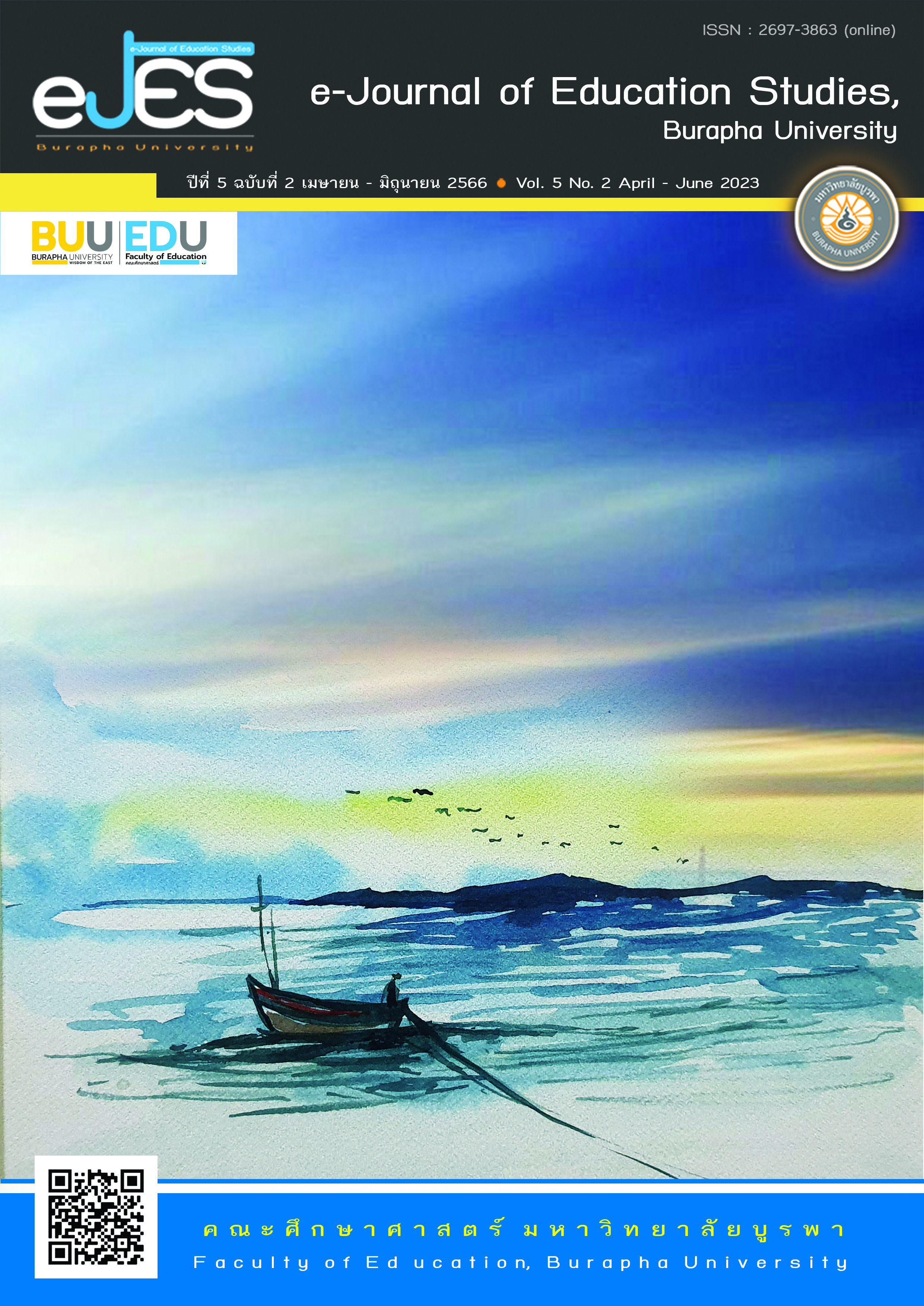Enhancing the Students’ Ability to Integrate Mathematics Learning Management through Active Learning Activities
Main Article Content
บทคัดย่อ
This paper presents a series of active learning activities aimed at enhancing students' ability to design and create integrated mathematics learning management across five thematic units: 1) Sports, 2) PISA, 3) Local Wisdom, 4) STEM, and 5) Philosophy of Sufficiency Economy. These activities encompass four teaching steps: 1) preparation, 2) exploration, 3) presentation, and 4) reflection. The study involved 20 mathematics major students enrolled in the first semester of the academic year 2022. The findings demonstrated that the students exhibited a high level of proficiency in designing and creating integrated mathematics learning management for each unit. The overall average score was 87.31%, indicating a commendable level of integration across different domains: STEM (96.0%), adherence to PISA guidelines (89.0%), integration of subjects and local wisdom (88.67%), integration within the sports context (84.0%), and integration of the philosophy of sufficiency economy (78.9%). The study strongly recommends focusing on active learning activities in each unit, such as group discussions, problem-solving exercises, interactive technology tools, and the utilization of educational games. These activities have shown the highest impact on students' abilities.
Article Details
เอกสารอ้างอิง
Bukhatwat, Ruqeishi and Khamisi. (2022). The usefulness of technology-based interactive methods in teaching mathematics and statistics at the college level. Shanlax International Journal of Education, 10(3) , 30-40. Retrieved form https://files.eric.ed.gov/fulltext/EJ1340904.pdf
Busadee, N., Laosinchai, P., & Panijpan, B. (2011). Possibility and probability lessons from popular sports. Mathematics Teacher, NCTM, 105(5), 373-378.
Chanthum, P., Tantinai, P., & Angganapattarakajorn, V. (2022). The effects of active learning management with Think – Pair - Share on mathematical reasoning ability and achievement of mathayomsuksa 3 students. Education Journal, Faculty of Education, Nakhon Sawan Rajabhat University, 5(2), 8-16. Retrieved from https://so02.tci-thaijo.org/index.php/edunsrujo/article/view/255289/173186
Chitchirachan, C. (2019). A model development of learning by integration of the sufficiency economy philosophy for potential development of students in the higher educational institutions of the northeastern region. Srinakharinwirot Academic Journal of Education, Faculty of Educarion, Srinakharinwirot University, 20(2), 161-171. Retrieved from https://ejournals.swu.ac.th/index.php/jedu/article/view/12357
Cho, Y. H., Caleon, I.S. & Kapur, M. (2015). Authentic problem solving and learning in the 21st century: Perspectives from Singapore and Beyond. Springer Education Innovation Book Series, Dennis KWEK.
Eseryel, D., Law, V., Ifenthaler, D., Ge, X., Miller, R. (2014). An investigation of the interrelationships between motivation, engagement, and complex problem solving in game-based learning. Educational Technology & Society, 17(1) , 42–53. Retrieved form https://www.jstor.org/stable/jeductechsoci.17.1.42
Isabel, V. & Barbosa, A. (2023). Active learning strategies for an effective mathematics teaching and learning. European Journal of Science and Mathematics Education, 11(3), 573-588. Retrieved from https://www.researchgate.net/publication/369660981
Klomim, K. (2016). Learning management based on STEM Education for student teachers. Journal of Education, Naresuan University, 18(4), 334-348. Retrieved from https://so06.tci-thaijo.org/index.php/edujournal_nu/article/view/70988
Klomim, K. (2019). Active learning management with integrated King's science to enhance problem solving skills and teamwork learning skills for student teachers in mathematics education. Humanities, Social Sciences and Arts, Veridian E-Journal, Silpakorn University, 12(1), 1242-1259. Retrieved from https://he02.tci-thaijo.org/index.php/Veridian-E-Journal/article/view/148245/147099
Lee, D., Morrone, A. S., & Siering, G. (2018). From swimming pool to collaborative learning studio: Pedagogy, space, and technology in a large active learning classroom. Educational Technology Research and Development, 66(1), 95‐127. Retrieved from https://www.researchgate.net/publication/321960690_From_swimming_pool_to_collabcollabo_learning_studio_Pedagogy_space_and_technology_in_a_large_active_learning_cclassroo
Lugosi, E. & Uribe, G. (2022). Active learning strategies with positive effects on students’ achievements in undergraduate mathematics education. International Journal of Mathematical Education in Science and Technology, 53(2), 403-424. Retrieved from 10.1080/0020739X.2020.1773555
OECD. (2018). PISA for development assessment and analytical framework: reading, mathematics and science. OECD Publishing, Paris. Retrieved from http://dx.doi.org/10.1787/9789264305274-en
OECD. (2018). PISA 2021 Mathematics Framework (Second Draft). PISA, OECD Publishing, Paris. Retrieved from https://www.oecd.org/pisa/sitedocument/PISA-2021-mathematics-framework.pdf
Rezaei, A. R. (2020). Groupwork in active learning classrooms: recommendations for users. Journal of Learning Spaces, 9(2), 1-21. Retrieved from https://files.eric.ed.gov/fulltext/EJ1273667.pdf
Stanberry, L. M. (2018). Active learning: a case study of student engagement in college calculus. International Journal of Mathematical Education in Science and Technology, 49(6), 959-969. Retrieved from 10.1080/0020739X.2018.1440328
Vanichwatanavorachai, S. & Homfung, C. (2018). The creative integration of local wisdom into teaching and learning in the 21st century. Veridian E-Journal, Silpakorn University, 11(3), 2551-2563. Retrieved from https://he02.tci-thaijo.org/index.php/Veridian-EJournal/article/view/161261
Zaki, A., Upu, H., & Minggi, I. (2021). Model-Eliciting Activities (MEAs) with integrated local wisdom as a mathematics learning model. IOSR Journal of Research & Method in Education, 11(6), 1-7. Retrieved from https://www.iosrjournals.org/iosr-jrme/papers/Vol-11%20Issue-6/Ser-4/A1106040107.pdf



